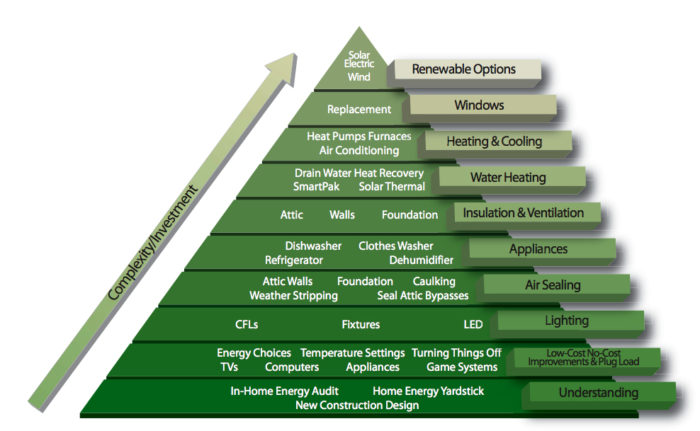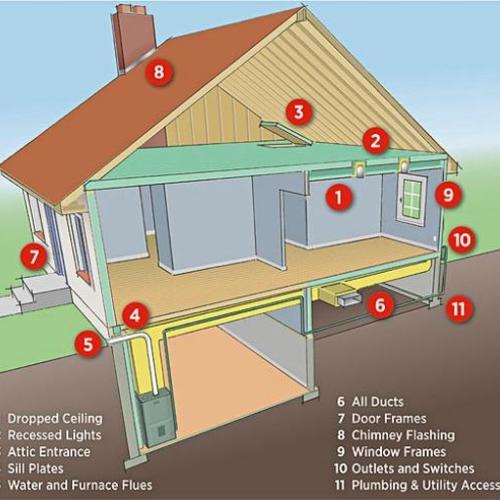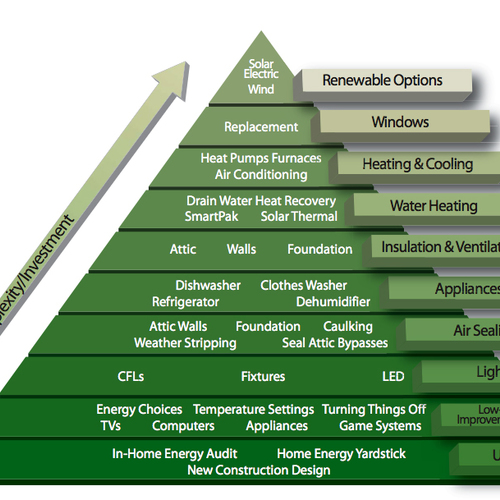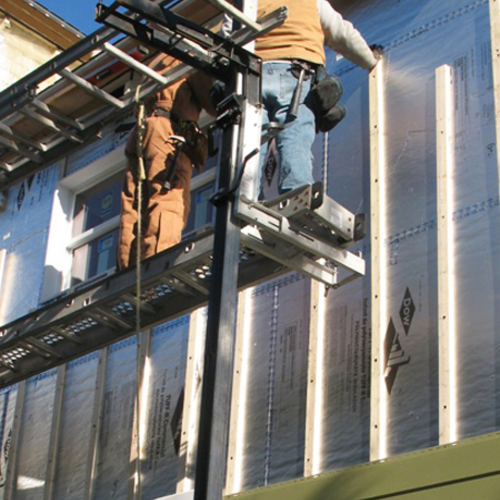
Image Credit: Minnesota Power
This information was UPDATED on August 4, 2023 in a post titled “A Few Ways to Lower Your Energy Bills.”
We’re all familiar with the food pyramid — the triangle with grains and cereals at the bottom and fats and sugars at the top. Inspired by the food pyramid, a Midwestern electric utility, Minnesota Power, has created a useful graphic called the energy conservation pyramid. (According to a Minnesota Power spokesperson, the originator of the conservation pyramid was Bob McLean, the chief operating officer at Hunt Utilities Group.)
The energy conservation pyramid includes ten levels. Like the food pyramid, it’s read from the bottom up. Homeowners who are uncertain of the best way to lower their energy bills should start at the lowest level of the pyramid and work their way up. In general, one shouldn’t proceed to a higher level until the actions below that level have been completed.
Actions near the bottom of the pyramid are much more cost-effective than actions near the top of the pyramid. At current energy prices, in fact, the actions listed on the top two layers are never cost-effective.
The rules displayed in the energy conservation pyramid are not set in stone; every house is different, and different climates dictate different strategies. But it’s hard to quibble with the pyramid’s basic hierarchy.
From the bottom up, here are the pyramid’s ten steps.
1. Home energy audit
Before beginning any energy retrofit work, a homeowner needs information — information best obtained through a home energy audit.
A good home energy audit always includes a blower-door test; most audits also include a thermographic inspection. To be sure your auditor is well trained, choose one certified by RESNET, BPI, or CBPCA.
A home energy audit can cost as much as $600. Thanks to subsidies from…
Weekly Newsletter
Get building science and energy efficiency advice, plus special offers, in your inbox.

This article is only available to GBA Prime Members
Sign up for a free trial and get instant access to this article as well as GBA’s complete library of premium articles and construction details.
Start Free TrialAlready a member? Log in















24 Comments
Appliances before insulation?
I like the pyramid theme but my list would prioritize insulation before appliances and HVAC would be right after insulation. Much depends on the current R-values and the improvement scenario, same with HVAC, if the furnace is 30 years old and 65% efficient, a 95% replacement looks mighty attractive.
Conservation before 'green bling'
Great! This is the type of public energy education we need out there!!
I live in a progressive community in Maryland. I am constantly frustrated when I see PV panels on 1950s brick ranches with original windows and I can only assume what missed opportunities lurk within. With our current uncapped federal subsides on production and capped subsides on energy conservation improvements It will take more than education alone to stop the problem of spending on production before conservation (thought it is a great place to start). Residential improvement subsidy rules for production need to be rewritten to get the incentives right (maybe a specific HERS score to qualify for a PV subsidy for example). We have a cultural propensity for the techno fix and showing off our values such as being green. For this reason people often go strait for the 'green bling' such as solar, wind turbines, or even ground source heat pumps before conservation. We have to properly educate and incentivize conservation investments first. In the age of global warming their is no other choice. Obviously federal subsidies are not encouraging conservation first but has any states tried to get the incentives right and encourage conservation measures before giving production subsidies?
The only thing I would like to see added to the pyramid is to make explicit about sealing and maintaining windows in rung 4.
Re: Appliances before insulation?
I agree with Doug appliances before insulation seems a bit funny. I don't have cost-ben data in front of me but maybe splitting up the type of insulation job on the pyramid would make sense. I would think simple attic insulation is more cost effective than appliances but maybe doing the stud bays on average would be less cost effective than some appliances? It would be interesting to see the numbers.
Appliances before insulation?
Doug and Kyle,
Whether or not to address appliances before insulation or insulation before appliances depends on the circumstances of the house.
If you have a 12-year-old refrigerator, it makes obvious sense to buy a new refrigerator before you spend $2,000 to hire a contractor to blow dense-packed cellulose into your wall cavities.
On the other hand, if your attic has only 3 inches of worn-out dirty fiberglass batts, and your appliances are relatively new, it clearly makes more sense to install 16 inches of cellulose in your attic than it does to replace your appliances.
Fixing Duct Leaks
I would think that one of the first items after #3 would be doing a duct blaster test along with the air sealing measures.....then fixing as many leaks as possible, replacing ducts as needed, etc. In CA, they estimate an average home leaks 30%!...seems like a huge energy hog...but we are a moderate climate. In more severe climates, maybe the HVAC contractors are held to a higher standard.
Not every house has ducts
Ed,
Remember, the pyramid was created in Minnesota. I assume that many Minnesota homes, like Vermont homes, have no ducts. They have hydronic heat distribution and no air conditioning.
Have to consider the house
Nice idea. However, I think I'd first consult 1) a good insulation contractor that also does air leak sealing around the attic and crawlspace, and 2) a good HVAC contractor to inspect and potentially recommend upgrades to the HVAC systems. Without knowing the cost of the high-ticket remedies, being out a few hundred bucks on an audit doesn't do me much good if I can't afford the fix. A good energy rater can probably prescribe the right solutions, but many homeowners would probably still find managing a retrofit pretty confusing.
insulation before appliances...mostly
I'm sorry , but this is bad advice. A 12 year old fridge had to meet 1993 standards and so the saving from a new unit might be about $50/yr and the payback likely 10+ years. Retrofit wall insulation might cost about $1.25/sqft and produce savings of 20 cents/sqft (more if gas prices bounce back) -- giving about a 6 year payback. The wall insulation is more cost-effective and the overall impact on energy use and bills is much larger .
Insulation, if needed, will go before appliances in most homes. Of course, unplugging second fridges goes before that. On the other hand, unplugging cell phone chargers seems sensible but is trivial.
ducts in Minnesota
Although they have a fair amount of hydronic heat, there are plenty of houses in Minnesota with ducts. But the ducts are in the basement and the basement is in the house, so duct leakage is not a big savings opportunity. Ducts go near the top of the list in regions where they put them in silly places like attics and garages and crawlspaces...
Thanks, Michael
Michael,
Thanks for your estimates of energy savings from refrigerator replacement and wall insulation.
Price for Installing Sidewall insulation
In response to Marcus on the cost of retrofitting walls with cellulose, I would estimate that that $1.25/sf to dense pack cellulose would quite a bit too low. It is very detailed and labor intensive work. We would hope the contractor has an infrared camera to check their work. We would also hope that the crew is following lead safe practices, OSHA safety standards, as well as fully probe the walls with a fill tube connected to a blower that is well maintained and able to dense pack. As a home performance contractor, I would say that $4-6 / s.f. is a better number to use. I think $1.25 is only possible by missing many of the steps I described as well as a very low wage for the employees.
Cellulose pricing
Richard,
If you are charging $4-6 / square foot for cellulose in a 2x4 wall you are ripping people off. If your insulation contractor is charging that much, he/she is ripping you off.
Where's the toilet?
Hi Martin,
The federal energy efficiency rebate program here in Canada provides a rebate for High Efficiency toilets. It takes energy to pump all the water used to flush toilets and there are plenty of 20 L and 13.5 L (5 and 3.5 gallon) toilets still out there. For a family of four, switching their toilet from an old 20 L toilet to a 6 and 3 L dual flush will save the household 119 cu.m/yr (29484 gallons/yr). Switching out 13.5 L toilets will save 72 cu.m/yr (18 564 gallons/yr). From Caroma's calculator.
If a households water is municipal the homeowners will see the savings directly in their water utility bill, and the utility will see the savings in their energy bill.
Homeowner's with their own well and septic system will see the savings directly in their electricity bill as their pump won't need to pump as much water... and they'll be pushing less volume through their septic system which should extend the life of the system as sludge and slime will have more time to settle out in the septic tank instead of ending up in the septic field.
The Maximum Performance (MaP) toilet testing has lots of HET toilets now. Here is the dual flush HET qualified fixtures list from cwwa.ca.
Tangentially, isn't it about time that building codes mandated HET fixtures? The requirement for six litre toilets came into the code quite a few years ago!
Cheers,
Andrew
pyramids make a bad graph
people only go for the low-hanging fruit. there is a reason the food pyramid doesn't work, either.
Going for the "low-hanging fruit" is the whole point
Mike,
I'm not sure I understand your point. You write that "people only go for the low-hanging fruit." If that were true, that would be a step in the right direction — if you are using the term "low-hanging fruit" in the usual way, meaning the most cost-effective measures.
I think that energy-efficiency experts are frustrated by an entirely different phenomenon: the people who start by going after the fruit at the very top of the tree. That's where resources are wasted. Going after the low-hanging fruit is a good thing.
Self serving?
The math may bear out the conclusions represented the pyramid, but does anyone think it might be self serving for the COO of an energy producing company to claim that generating your own power is "almost never cost effective"?
Response to Vt Yankee
Vt Yankee,
The words you quote are mine. They are not the words of "the COO of an energy producing company."
With few exceptions, generating your own power is significantly more expensive than buying it from the grid. The exceptions are found on remote islands or in northern Alaska, where the local utility has extremely high electric rates.
I know that this statement is true because I live off-grid, and have been generating my own electricity for 30 years.
Pyramids
I see this as two pryamids. The first being the order of investiagtion and considerations and second, the pryamid adjusted for the results of that investigation. The pryamid will be a little different for each house.
Secondly I am dissapointed stil that the only reason considered to make energy improvements is how much money it will save. I think it would be great if people consider the positive impact on the planet and the climate as well - this is why were going green, You also get some pay back though from inreased home value at least in my area.
Lastly as a Home Inspector having inspected 11,000 homes I was supprised to hear exterior caulking stated as a waste of time. I have never seen a house that had inadequate caulking without associated problems; rotted trim, leaking windows, mold in wall and such, but I agree you can't just caulk your way into energy efficientcy.
DWHR + Hvac System size
To follow up on Doug McEvers comment, home owners may be able to purchase smaller, less expensive HVAC systems after properly insulating a home and reducing the heat load.
A second comment I have is how far up the list Drain Water Heat Recovery is. I work as an Energy Advisor for new homes in Victoria, and any home that I work on that is more than 1 level I recommend these systems. Passive, cost effective, and the things last 50+ years. They always have a reasonable pay back, and In my opinion they should be standard in any new home, and recommended for any retrofit where it is feasible to install them.
Natural Resources Canada even made a hilariously awkward introduction video to DWHR on YouTube
https://www.youtube.com/watch?v=JOsUQZPPLoo&list=UUv4UAWT20Z4u_cF8CEk2S_A&index=3&feature=plcp
Reponse to Mike Young
Mike,
Thanks for your comment. I'm also a big fan of drainwater heat-recovery devices -- they are great. The only caveat: they won't do much for you if your family prefers baths to showers.
Update for different renewable economics?
A colleague just passed this my way, and I must say - while I agree with the general concept, EEK! it doesn't paint renewable energy in a particular good light, does it? I mean - replace windows instead of installing PV? Can someone update this for the changes to solar economics?
Even in the now state rebateless environment of Maine, we can offer better than 10-year simple payback on solar PV systems. In more generous markets, like Mass to the south, you can be in the 5 years or less ROI scenario for a system paid in cash. That's better ROI than most energy star fridges!
- Fred
Response to Fred Greenhalgh
Fred,
You're right. This article is more than 3 years out of date, and it is obsolete. It is absolutely true that homeowners should install a PV array before replacing windows -- assuming, of course, that they have an unshaded south-facing roof or an unshaded section of lawn that they can devote to PV.
PV viability
PV solar is becoming more and more viable, even under not completely favorable conditions. I'm in Oregon and my roof faces east and west and is shaded to the point where I don't even quality for the state and utility rebates (my solar "resource" is 65%). Still, with the federal tax credit, and Oregon's feed-in tariff (which is supposedly not even that good of a feed-in tariff), it would be profitable to the tune of 20-40 thousand dollars over the 25 year expected life of the equipment. The only problem is that I can't find a loan with a long enough term to make the cashflow positive during the first 10 years or so. For someone willing to make that 10 year investment, it would pay off nicely. And that's with my not-even-close-to-ideal roof and rather cloudy climate.
Response to Nick Welch
Nick,
This article is three years old, and the economics of PV have changed radically since the article was written. I have just updated the article. Thanks for the nudge.
Log in or become a member to post a comment.
Sign up Log in